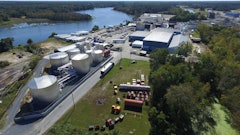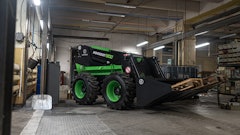
To ensure a successful installation, door installers can take basic steps to avoid some of the many complications that may occur throughout a door and hardware project. With proper planning and work along the way, unnecessary installation delays and costs can be prevented. While the complexities of installation range far more than the scope of this article, here are some mistakes to look out for on your next project.
Improperly Storing Material
In general, all material should be stored inside a covered, controlled area to protect against the elements whenever possible. Assembled/welded frames should be stored in the vertical position at least four inches off the floor. If frames are not stored correctly, frames are subject to rust and other damage. Metal doors on a pallet should be stored horizontally in the original packaging no more than 10 inches high at least four inches off the floor. Otherwise, individual metal doors should be stored in a vertical position at least four inches off the floor. If not stored correctly, doors are subject to bowing, rust, and other damage. Wood Doors should be stored flat horizontally in a dry, humidity-controlled environment. Handle with clean gloves and do not drag doors across the stack to prevent damage to the veneer. If doors are not stored and handled correctly, doors are subject to scratches, bowing and warping.
Not Verifying Frame Installation is Plumb, Level, Square, and True
If a frame is not installed correctly, it is very difficult to get the opening to operate as desired. Before installing doors and hardware, always verify the frame installation. When a frame is installed level, the spacing between the door and the frame when the door is closed will be uniform. A frame installed out of plumb may cause sagging, hinge binding, and the door swinging closed or opening on its own. Likewise, a frame installed square will prevent these unwanted conditions as well as making sure there is proper sealing between the door and frame. If all of the above is done correctly, the frame is installed true, which is square on both the level (horizontal) and plumb (vertical) axis, providing the optimal frame installation for door operation.
Using the Wrong Anchors
Using the appropriate anchors for the wall type will ensure that the frame is secure, solid, and does not budge when the door is opened and closed. Incorrect anchor usage dramatically affects the operation and lifetime of the opening assembly. Always verify that the anchors being installed are the correct anchors for the application.
Incorrect or Unauthorized Frame and Door Preps
Incorrect preps made to the frame and/or door may cause hardware failure and also promote an unsafe opening. Having doors and frames prepped correctly before hardware installation will reduce the installation time and improve quality. Any modifications made to openings after installation must be done by a certified professional. Unauthorized modifications or modifications done by uncertified installers may invalidate warranties and ratings. Ensure that installers working on doors, frames, and hardware have the necessary credentials, certifications, and training to make authorized modifications to openings.
Unnecessary or Improper Grouting
For drywall construction, grouting should never be used. Improperly grouted frames will lead to premature rust and replacement of the entire opening. In the case where sound deadening is required, alternative materials can be used to accomplish the same rating.
Not Removing Frame Spreader Bars
Frame spreader bars should always be removed prior to frame installation. Spreader bars are only used to maintain the integrity of the welded frame during shipping, and should not be in place when a frame is ready to be installed.
Using the Wrong Screws
It is essential that the correct fasteners are used when installing hardware. Using the wrong screws to install hardware will likely diminish the performance and lifetime of installed hardware. In addition, not using the correct screws may void hardware warranties. Always use the screws provided with hardware or reference the installation requirements of the hardware to ensure proper installation.
Not Being Aware of Door Handing
When preparing for hardware installation, always double-check the handing of the door. While some hardware is independent of the handing of the door, some hardware is handed. Not being aware of the handing of a door relative to the hardware being installed, can prove very costly. For example, installing a door closer on the wrong side of a door will likely result in replacing the entire door.
Not Testing for Proper Operation
When installation is complete, always test the opening for proper operation. Does the door open and close as desired? Has all required hardware been installed? Likewise, an improperly installed frame or hinges, may lead to door binding where the door does not close smoothly. This may be rectified by shimming or adjusting the frame. If the opening does not operate as desired, immediately assess what adjustments may be made to ensure proper operation. If the opening is not tested after installation is complete, maintenance will likely be required prematurely.
Not Using Correct Material for the Application
Before installing the material on an opening, always verify that the material being used meets the requirements of the opening. Fire ratings, sound transmission ratings, and other operating requirements dictate what material should be used. Not using the correct material may prove very costly and require a lot of rework. Having and correctly installing the material required will lead to a successful project.
In addition to the items above, it is essential to communicate about installation needs with other trades and contractors that may be working in coordination with items in your project scope. Once installation is completed, providing protective coverings for doors and hardware can also reduce the likelihood that the products installed get damaged by others during the final phases of the project. With all the challenges installers face, hopefully these tips will prove helpful on your next project.
(Warren Doors & Access Control is a commercial hardware distributor and access control integrator headquartered in Pensacola, FL. As a proud family-owned business, our team’s mission is to supply the highest quality products in the door industry while building customer trust through superior service. Visit us online at SecuringTheSoutheast.com)


























